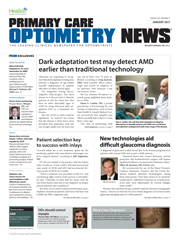Primary Care Optometry News Current Issue

The following articles appeared in the print edition of Primary Care Optometry News.
Table of Contents
- Optometrists should be treating myopia progression Thomas Aller, OD, FBCLA
-
- Corneal inlays provide another option for presbyopes Jeffrey M. Augustine, OD
- Researchers estimate nearly 1 billion with high myopia by 2050
- Studies show promising results for PiXL procedure in low myopia
- Use newer technologies to detect glaucoma in challenging patients Elliot M. Kirstein, OD, FAAO
- Abnormal dark adaptation: An early biomarker for AMD Michael D. DePaolis, OD, FAAO
- Diabetic retinopathy correlates with hearing loss
- Diabetics cite many reasons for noncompliance with dilated eye exams
- Patients report more comfort, tolerability with personalized PALs
-
- Smartphone use, urban living possible risk factors for DED
- Study does not support field improvement after IOP-reducing therapy
- Vessel density indicates glaucoma severity using OCT-A
- Weight loss after bariatric surgery weakly correlated with IOP lowering
- Color contact lens wearers report high satisfaction
- Digital device use intensity affects toric lens comfort
- Look to the gut for autoimmunity, says speaker at Ocular Nutrition Society
- Midpoint, max-plus refraction equivalent after inlays
-
- Patients report 30 days of comfort with lotrafilcon B lenses
- Speaker: Glaucoma on the cusp of personalized medicine
- Survey: Most practitioners do not screen for MGD
- Tear osmolarity provides data on level of ocular stress
- Vitamin D is underestimated, researcher says
- Dark adaptation test may detect AMD earlier than traditional technology
- Suspicious, growing lesion on lower lid Leonid Skorin Jr., OD, DO, MS, FAAO, FAOCO; Maria Joan Spadaro, CNP; Zachary Lundgren, BA
